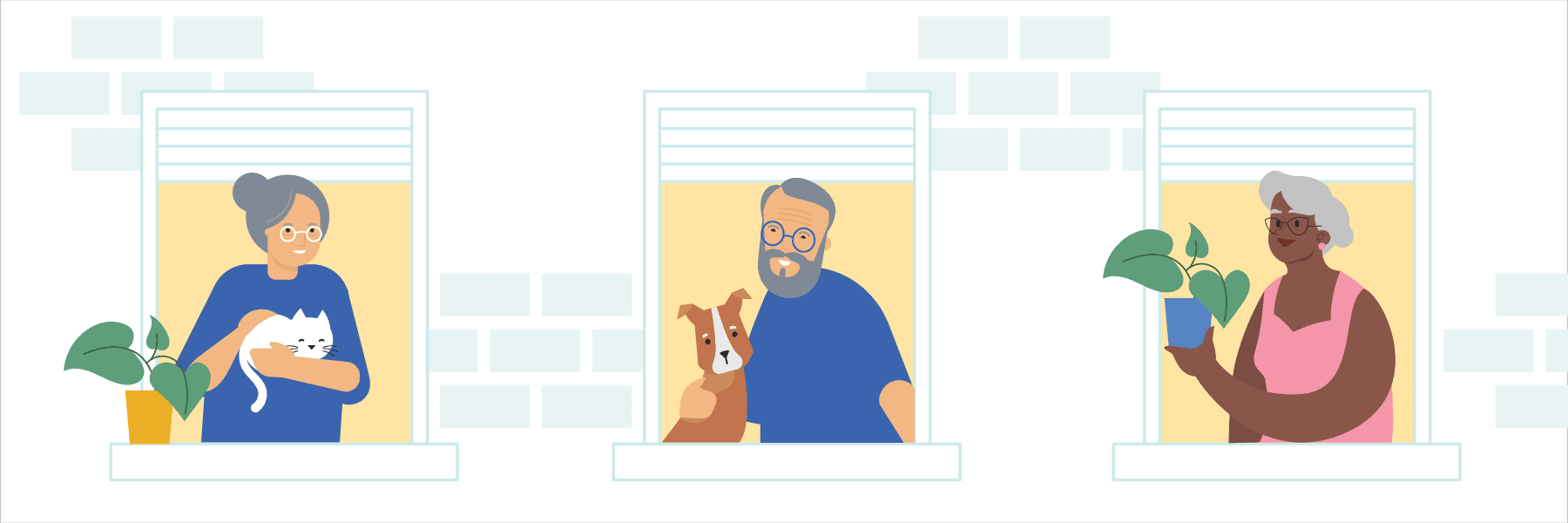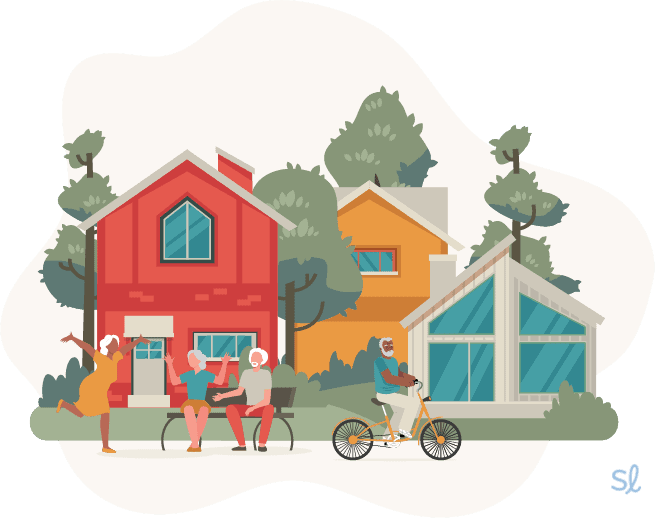Senior Cooperative Housing
A Complete Guide to Senior Co-op Housing in 2025
SeniorLiving.org is supported by commissions from providers listed on our site. Read our Editorial Guidelines
Find Senior Cooperative Housing Near You
Join 1,085,046 Seniors Who've Found Housing Communities on SeniorLiving.org.
Or Call: (855) 241-1699Find Senior Cooperative Housing Near You
Although vastly popular, traditional 55+ communities, retirement homes, continuing care retirement communities, and your current home aren’t your only independent living senior housing options. Since the late 1970s older adults have had another option: senior cooperative housing, or senior co-ops.
Active 55 and older residents own a share of the community in senior cooperative housing, and they have an equal say in how it is run. You get the tax benefits of homeownership without the hassle of home upkeep. This makes an ideal transition from longtime home ownership to a more maintenance-free life.
Below, we’ll explore senior cooperative housing in depth, including how it works, what amenities you can expect, and how much it costs.
Table of Contents
- How Does Senior Cooperative Housing Work?
- Who Lives in Senior Co-Ops?
- Types of Senior Cooperative Homes
- Senior Cooperative Housing Amenities and Services
- What Are the Differences Between Senior Co-Ops and Condos?
- How Much Do Senior Cooperative Housing Communities Cost?
- Paying for Senior Cooperative Housing
- Is Senior Cooperative Housing Right for You?
- How to Find Senior Co-Ops Near Me
How Does Senior Cooperative Housing Work?
Senior co-ops operate a little differently than other types of senior living.
A senior cooperative housing community is a nonprofit corporation. Residents own the building and land collectively with the other residents. Those living in the community buy stock in the corporation and become shareholders. Your stock is prorated in value based on the size (square footage) of your home or apartment.
Becoming a resident and shareholder requires two costs: a one-time share cost and a monthly fee.
Think of your share cost as a down payment on the unit where you’ll live. Think of the monthly fee as rent, community, and maintenance fees.
Part of the monthly fee covers your share of the principal and interest for the master mortgage. It’s typically insured by the Office of Housing and Urban Development (HUD) on a 40-year note at a competitive interest rate.
The rest of your monthly fee often goes toward:
- Property taxes
- Parking
- Water and sewer service
- Trash and recycling removal
- Lawn care, landscaping, and snow removal
- Property maintenance
- Management services
- Fire protection/security system
- Access to shared spaces and amenities
- Possibly other utilities, including heat and electricity
- Fund reserve
A fund reserve helps the co-op to afford replacements and repairs in the future. For example, many co-ops own the appliances and cover the cost of repairs in individual units. If your fridge breaks or you have a plumbing problem, money from the fund reserve would cover the cost of replacing your refrigerator or fixing your plumbing.
Like a condominium, you have occupancy rights as long as you pay your monthly payment. Stop paying and the co-op can “force sell” your membership.
Do I Actually Own My Home in a Senior Co-Op?
When you buy into a senior co-op, you don’t actually own your unit or home. Instead, you’re a shareholder in the nonprofit corporation that owns the entire property. However, you do still benefit from homeowner tax deductions, such as mortgage interest and real estate tax deductions.
And unlike buying a house or condo, co-op housing shouldn’t be looked at as a major investment. Most senior co-ops operate as limited equity cooperatives (LECs). They aim to provide affordable housing options to the first residents and to keep ownership affordable over time. Often, the share price increases by 1 to 2 percent each year regardless of the real estate market.
What Happens If I Want to Move Out of a Senior Co-Op Community?
Planning to move somewhere else? If you decide to sell, the cooperative usually retains the first option to buy. Whether the cooperative or a new resident buys, you receive your share cost and any accrued equity from the sale. Typically, the co-op helps market and sell the home. The co-op must also approve the new shareholder (buyer).
Our free housing and care finder uses your unique needs to curate a list of the best options in your area.
Who Lives in Senior Co-Ops?
Seniors, of course!
Generally, senior co-ops are full of older adults who are:
- Age 55+
- Able to live independently
- Single, married, or widowed
- Middle- to upper-middle-income level
Just like other age-restricted retirement communities, senior cooperative housing communities must follow relevant laws. This typically means that 80 percent of homes must be occupied by households with one member who is 55 or older. Some senior co-ops cater exclusively to older adults ages 62 and up. Be sure to ask about residency age requirements when researching co-ops in your ideal retirement destination.
However, research from 2013 suggests that residents are often much older than that. The median age of residents was 73 to 74 years old, with most residents falling between the ages of 56 and 92.1
Types of Senior Cooperative Homes
Some senior co-op communities look like high-rise apartments, but that’s not always the case. You can find senior co-ops that were built within a remodeled public school building. Others are neighborhoods of single-family homes, townhomes, multifamily homes, manufactured homes, etc. Just remember, when you buy into a co-op, you’re not buying the physical property.
FYI: Many senior co-ops have waiting lists. So if you think a housing cooperative fits your post-retirement budget and lifestyle, it’s never too early to get your name on a waiting list.
Along with the unit you live in, you’ll also have access to common areas. These also vary depending on the type of senior co-op. Larger, more luxurious senior cooperative housing might feature heated pools and fitness centers. More economical co-ops might just offer a shared dining space, community kitchen, and workshop.
Senior Cooperative Housing Amenities and Services
Senior cooperative housing communities offer many of the same amenities you’d find in a nice apartment building or condo. They might include:
- Fitness room
- Community kitchen
- Library
- Community room
- Workshop
- Laundry facilities
- Guest rooms
- Indoor, heated parking
- Outdoor gardens with raised beds
Along with access to shared spaces, shareholders who live in senior cooperative housing communities also enjoy access to services that make life a little easier.
Typical services include:
- Resident managers
- Maintenance of common areas and home appliances
- Housekeeping for the common areas
- Landscaping and snow removal
- On-site transportation
- Social activities, such as book clubs, field trips, discussion groups, movie nights, happy hour, and many others
Did You Know? Many co-ops have plans in place if residents require some extra help. For example, neighbors might lend a helping hand, or you’re welcome to hire home health care aids to offer assistance with activities of daily living.

SeniorLiving.org is supported by commissions from providers listed on our site. Read our Editorial Guidelines
What Are the Differences Between Senior Co-Ops and Condos?
A senior co-op might sound similar to a condo, but they’re two very different living arrangements.
Seniors who live in condos own the condo unit and a percentage of the common areas. They often secure their own mortgage to finance the purchase and must pay condo association fees. Condo association fees often include maintenance of community areas, landscaping, and management fees. However, you’re typically responsible for paying your own utility bills.
Residents of senior cooperatives own shares in a corporation, which allow them to lease an individual unit to live in. Typically, they use cash (not a private mortgage) for the down payment and other personal income to cover monthly fees. Residents make a single monthly payment to the cooperative, and then the leaders of the co-op pay for the master mortgage, landscaping, insurance, cable TV, maintenance, utilities, etc.
With both condos and co-ops, the owners and shareholders have a say in how the community is run. Co-ops tend to be more hands-on, giving each shareholder an equal voice. They also tend to have stricter vetting processes for new residents.
How Much Do Senior Cooperative Housing Communities Cost?
The cost of senior co-op communities varies. And not all co-ops operate in the same way. However, most charge an upfront fee, called a share price or share cost, and an ongoing monthly fee, which might be called a carrying charge or maintenance fee.
The share cost represents a portion of the cost of your new living space. It can be significant, usually 20 to 40 percent of the unit’s value. Typical unit prices range from $100,000 to $225,000 or more.
The carrying charge is determined by the board of directors at the senior co-op. That means the people who set the budget and monthly fee are fellow shareholders who will be paying the same fee. Some communities let you invest more upfront (60 or 80 percent) in exchange for paying lower monthly fees.
Research from 2013 suggests that seniors need a yearly income of $18,000 to $37,000 to afford to live in a co-op.1 For reference, the median income for U.S. adults age 65 to 74 is $55,747, and for adults age 75 and older, it is $38,239.2
Paying for Senior Cooperative Housing
Seniors nearly always pay privately for their shares and ongoing monthly fees in a senior cooperative housing community. You might use savings, proceeds from the sale of a home, proceeds from selling a business or other assets, or withdrawals from an investment or retirement account.
Typically, a traditional home mortgage isn’t an option. Most lenders don’t underwrite mortgages for cooperative housing communities because you aren’t actually buying property. Instead, you’re buying shares in a corporation.
And since co-ops aren’t medical facilities or traditional senior living facilities, they don’t accept Medicare, Medicaid, or long-term care insurance. However, if you need in-home services, you may be able to use insurance to cover those expenses; for example, physical therapy in your home, a personal care companion, rehabilitation services, etc.
Is Senior Cooperative Housing Right for You?
If you’re a baby boomer retiree looking for an alternative senior living option, senior cooperative housing may be the counterculture flashback you’ve been looking for. And while co-op living is not exactly a senior commune or kibbutz, it shares many social aspects, such as a community garden, on-site activities, and clubs.
It’s also becoming increasingly popular in the U.S.3 Seniors need more affordable and accessible independent living options. And senior cooperatives tend to prioritize the well-being of residents over making a profit.
A study from Ohio State University also suggests that seniors who live in co-ops live well. The majority of residents felt that life in a co-op had a positive effect on the following:4
- Ease of maintaining home: 93 percent
- Ability to live independently: 84 percent
- Personal safety: 82 percent
- Life satisfaction: 80 percent
- Access to activities and entertainment: 77 percent
- Happiness: 77 percent
- Amount of contact with friends: 77 percent
- Personal privacy: 67 percent
- Physical health: 63 percent
How to Find Senior Co-Ops Near Me
Although they started in the Midwest in 1978, senior cooperative housing is gaining some traction in the South and West. You can find communities in Florida, Texas, Arkansas, and Washington. However, over 60 percent of the more than 140 communities across 12 states are in Minnesota.5
Visit the Senior Cooperative Foundation to view senior housing cooperatives by state. Its directory includes 141 facilities across 12 states.
Not able to find a senior housing co-op in your area? That’s OK! Use our senior housing directory to search for other senior housing options by ZIP code.
Semantic Scholar. (2013, Aug 9). Innovations in Housing and Assistive Services to Support Aging in Place.
U.S. Census Bureau. (2022). HINC-02. Age of Householder by Total Money Income in 2021, Type of Household, Race and Hispanic Origin of Householder.
Senior Housing News. (2019, Sept 5). Why Co-Op Senior Housing Is Ready for Primetime.
The Seattle Times. (2021, Oct 22). Is a co-op retirement community right for you?
Senior Cooperative Foundation. Housing List.



